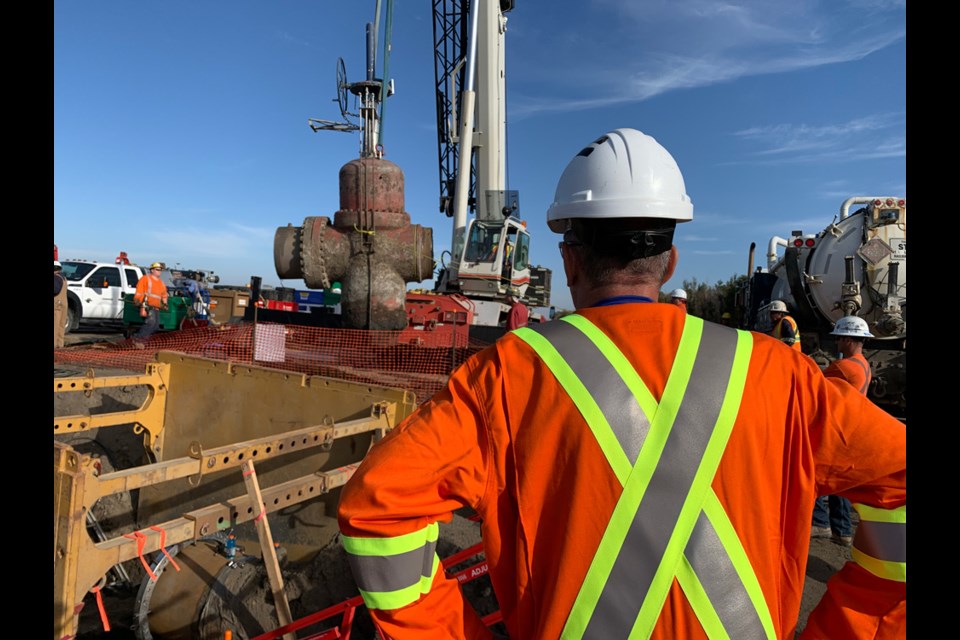Work to decommission Enbridge’s “legacy” Line 3 pipeline continues in 2022.
Along a 1,097-kilometre corridor – stretching underground across the Prairies from Hardisty, Alta., to the U.S border at Gretna, Man. – is a new, 36-inch pipeline placed into service by Enbridge in October 2019. The above-ground pipeline right-of-way has returned to its pre-construction condition.
“This is the final step toward completing the entire Line 3 Replacement Program in Canada,” said construction manager Allen Sawatzky. “We’re done in most of Manitoba and this year we’re focused on the remaining segments of Line 3 from Hardisty and throughout Saskatchewan to west of Cromer (Manitoba).”
The decommissioning project in 2022 will focus on three segments, beginning with the 255-kilometre leg from Regina to Cromer in late spring, followed by Hardisty to Kerrobert (176 kilometres) and Kerrobert to Regina (355 kilometres) in late summer and into the fall.
The general contractor for Hardisty to Kerrobert is Gee Bee Construction while the general contractor for Kerrobert to Cromer is Maxx North American Services Ltd.
Work in each segment will have a peak workforce of about 60, including crews of between seven and 10 construction and contract personnel.
“Decommissioning is a logistically challenging job,” said Sawatzky. “It’s different than building a pipeline – you don’t just work from kilometre zero to kilometre 100 in a straight line. You go back-and-forth, from site to site, and the particular job in Manitoba in 2021 involved 31 different locations for segmentation, valve isolation and for installing engineered material in the pipe beneath railway and road crossings.”
There are 23 locations for segmentation, valve isolation and railway fill between Hardisty and Kerrobert, 34 locations between Kerrobert and Regina and 40 locations between Regina and Cromer.
Decommissioning 101
A decommissioned pipeline is defined by the Canada Energy Regulator (CER) as one that is taken out of service safely and permanently, while other existing or new pipelines in the same right-of-way continue to provide service to end users.
Enbridge has approval from the CER (formerly the National Energy Board) to decommission Line 3 in place, a standard practice which minimizes the potential effects on communities and the stability issues that surround soil disturbance.
“Leaving the line in place avoids disturbance from the significant construction required for excavation and removal,” said Terry Kwasniewski, manager of projects at Enbridge. “It also reduces risk of soil and slope instability, settlement and compaction that could compromise the safety of active pipelines sharing the right-of-way.”
Line 3 decommissioning involves cleaning, disconnecting, segmenting, filling the pipeline at strategic points and ongoing monitoring, even after decommissioning is complete.
Here is a look at the five steps involved in decommissioning:
- Clean the pipeline: A combination of cleaning instruments (often referred to as ‘pigs’) and cleaning solution are used to wipe and clean the pipeline.
- Disconnect the pipeline: The pipeline is physically disconnected and sealed off from active operational facilities, like pump stations, to prevent oil from re-entering the system.
- Segment the pipeline: Permanent physical barriers are created inside the pipeline to prevent the pipeline from acting as a conduit. This includes valves and permanent segmentation installations. Valves are closed and permanently disabled, and small pieces of the pipeline are removed so it can be sealed at select locations.
- Strategically fill the pipeline: The line will be filled with an engineered material at railway crossings, which can also provide protection against water conduits.
- Monitor the pipeline: Cathodic protection will continue to be applied to the decommissioned pipeline. It will be monitored with regular pipeline patrols, pipeline signs indicating exact location, and depth-of-cover surveys, and it will remain on Click Before You Dig program databases.




